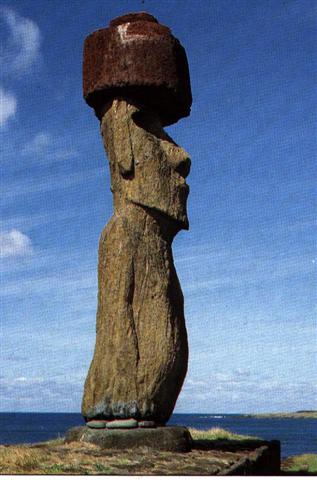2. The function of cocks and chiefs to ascertain the arrival of 'fruits' (hua) of all kinds on the island has made me conclude there is a wordplay involved between moa and moai (the statues). I read moai as moa-î, where the meaning of -î is 'full', 'abound', 'be plentiful'. For example: ki î te îka i uta, 'as there are lots of fish on the beach'. Makemson has suggested the statues, standing high and erect, to have been raised to guarantee a fertile land: ... the embodiment of sunlight thus becomes, in the form of a carved human male figure, the probable inspiration for the moai as sacred prop between Sky and Earth. The moai as Sky Propper would have elevated Sky and held it separate from Earth, balancing it only upon his sacred head. This action allowed the light to enter the world and made the land fertile ... The statues are made from stone: mae'a Matariki, Pleiades-stones, according to Churchill. When the Pleiades rose in the east before the sun the time of rising sun was announced: ... I think it is probable that the Rapa Nui ritual calendar, as that of the Maori, Mangarevans, Samoans, Tongans and other Polynesians began in July following the rising of the Pleiades. On Rapa Nui and many other islands, the Pleiades were called Matariki... According to Heyerdahl, when the islanders were asked why there were no ure (penis) on the stone giants an old man calmly replied: 'A moai cannot have two ure, he is one himself.' As to the form of the moai statues a famous myth confirms: "Métraux quotes a Rapa Nui legend in which carvers from Hotu Iti (eastern sector) journeyed to the western sector to seek the advice of a master carver. They were perplexed about how to resolve the difficult problem of carving the statue neck. He advised them to seek the answer by viewing their own bodies. They did so, and discovered that the model for the statue neck was the penis (ure)." (Van Tilburg)
|
